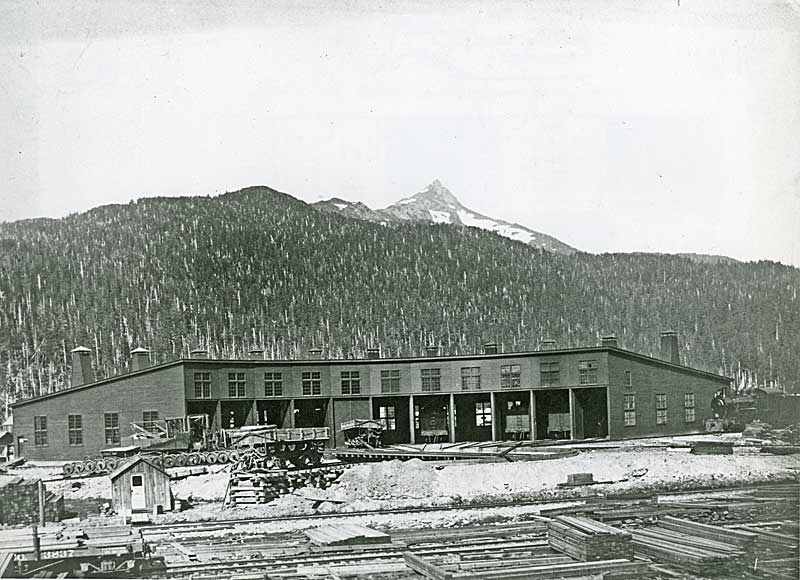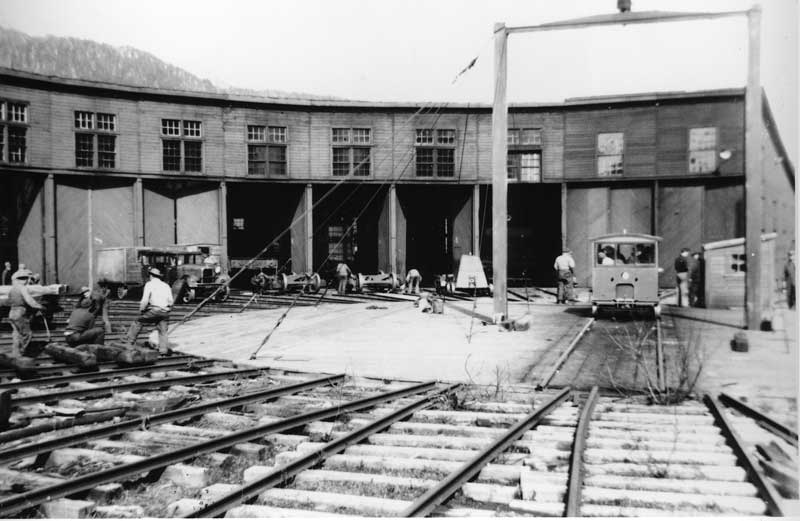Chapter 12, Pt 1: "Mary and Stephen Birch Arrive at Childs Glacier" | ||||||||
click on picture for larger image: these pictures are the one which appear in the book for this chapter. | ||||||||
Locomotive no. 74 was the fifth and last of the series of great engines of the Mikado class type purchased to upgrade Stephen’s ore train fleet. The CRNW had no 100-ton crane at the wharf, which was the minimum capacity needed to off-load the 95-ton locomotive. Tidal fluctuations at Cordova allowed an alternative means to deal with so large a piece of rolling stock cargo. The ship was kept in position until the tide lowered the reinforced deck to the same level as the dock. While the ocean level at the dock dropped the necessary twenty-two feet, the men installed rails from the engine to the edge of the ship on top of heavy planking. The engine was already sitting on rails bolted to planking. It had been loaded into place at Seattle using a large crane, which made the setting of the engine into place an unusually difficult feat. Yet there it sat, still heavily tied into place, still sitting comfortably on those seventy-five pound rails just as it had when it was so carefully dropped into place. The men ran temporary rails to the point on the dock where they would meet with the ship, running past the dock’s edge eight feet so that there would be no joint between the ship and the dock. The railroad workers joined the temporary rails at the critical moment when the tide level was perfect for the transfer. CRNW engines #70 thru 74 were the same series and were used primarily as ore-haulers By then, the tie-downs were removed and the engineer had the locomotive steamed up and ready to move. He stayed with the engine to ensure that the steam pressure and water levels remained just right for moving the massive locomotive under its own power. When the moment came, the men performed a final alignment of the rails and bolted them together. The foreman signaled the engineer and Dusty pull the reverse handle, allowing the engine to creep forward. The engine had been loaded so that it would point toward the dock, given the most likely way the ship would approach the wharf. The extremely heavy, self-powered load departed the ship with considerable creaking through the rails, the ship and the dock. The stevedores ensured that the ship could not dip because they had temporarily secured it tightly against the dock. It was imperative that the engine not tip at all. It left the ship smoothly. Stephen Birch and his party watched the entire procedure. He had asked the company to alert him when the tide was in the right position. His party arrived in a horse-drawn carriage owned by the hotel. The engine rolled onto the dock without a hitch to a loud round of applause. The loud whistle reverberated as the engine moved off to the eleven-bay roundhouse for a final check. Mogul No. 102 was the back-up assigned to Stephen’s private train. At eighty tons, it was considerably smaller than the Mikado which had just arrived. With its six large drive wheels, the engine could pull a small consist in excess of sixty miles per hour over most of the line. The mogul was ideal for Stephen’s private train, but it would not be used. Stephen wanted to use the newest and proudest, if an inanimate object could be described that way, of the great CRNW engines. He left no doubt to Superintendent Hansen that he wanted his private train headed by the mammoth No. 74. So it would be.
On the day the engine was ready, Stephen was at the turntable to watch No. 74 pull out of the bay onto the turntable. A worker started the powerful electric motor which swung the huge engine around until it was lined up with the exit rail. No. 74 blasted its whistle and rumbled off the wooden turntable deck. The crew linked a combination baggage and passenger car behind the tender and then added “The Kennecott” to the rear. All was ready for the train trip into the great interior over the “Route of the Marvelous Scenic Wonders.” In 1916 the CRNW was still the only standard gauge railroad entering interior Alaska, though the new Alaska Railroad would soon be operating a much larger line out of Seward to Ship Creek and beyond. The first passenger cars would travel the line from Seward to the new town of Anchorage in October. The government-built railroad would ultimately reach Fairbanks in mid-July, 1923--seven years after the Birch honeymoon trip. The choice of the government to build the railroad out of Seward instead of purchasing the existing CRNW and using the Cordova terminal guaranteed the end of the CRNW when the mining engineers declared Kennecott’s interior copper mines to be exhausted in 1938. Yet in the summer of 1916 it appeared that the CRNW was a permanent railroad which would last almost forever. In the few years since the railroad first opened its line to the Bonanza Mine the CRNW had filled in many of the long trestles which crossed the expansive Copper River delta with tens of thousands of cubic yards of gravel fill. Permanent steel bridges existed at CRNW mile 27, 34, 49 and 144. The railroad met high engineering standards and was considered a first-class system at least as far as CRNW mile 131, which was the Chitina depot. The consist left Cordova after five days instead of the two which Stephen had planned because Mary claimed to be too ill to travel. By the time Mary decided she was ready to travel, she was becoming quite unpopular with the rest of the party.
|
Chapters from the historic novel "Legacy of the Chief," by Ronald Simpson, and other items mostly related to the historic background of the Ahtnas in the context of Kennecott Copper & its Copper River & Northwestern Railway.
05 November 2010
Ch 12, Pt 1: "Mary & Stephen Birch Arrive at Childs Glacier
Subscribe to:
Post Comments (Atom)





No comments:
Post a Comment